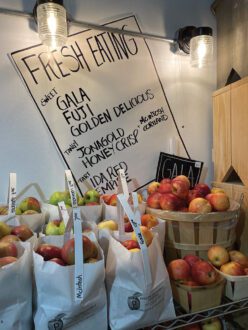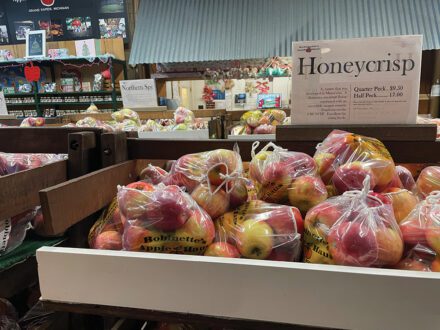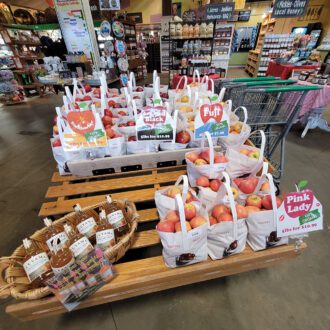
May 7, 2024Inflation, farm input costs shape farm market prices
Properly pricing farm market produce and goods can be difficult. If a manager prices too high or not high enough, sales and profits could slip.
The latest Fruit Growers News Farm Market Pricing Survey shows factors influencing how leading farm marketers charge for fruits, vegetables and other food.


Farm markets from 39 states as well as three Canadian provinces participated, with most participants from Michigan, Pennsylvania, New York, Wisconsin, Indiana, Illinois, California and Washington.
The survey showed inflation and input costs forced 80% of the respondents to raise prices. Most managers raised costs of production by 10% to 30%.
Markets seem to be looking for ways to distinguish themselves from competition by highlighting and charging a premium for certain varieties.
DOWNLOAD THE 2024 FARM MARKET REPORT NOW
Keeping up with the competition
To determine prices, most farm market managers consider a number of factors, including competitors’ pricing (58%), input costs (51%), grocery store prices (40%), availability of product (39%), grower input (28%), profit margins (22%), or based upon a specified set of markups (9%). Twenty-five percent chose “all of the above” to the question.
Brian Moyer, education program associate with Penn State Extension and founder/director of PA Farm Markets, noted the majority of respondents in part base their prices on their competitors’ pricing — a practice he counseled farm market operators to avoid.


“It is good to know what your peers are selling and how much, but don’t let it be the driver of your pricing strategy,” he said.
On the other hand, using expenses such as inputs, and considering multiple factors in determining prices, is a smarter strategy, Moyer said. Basing prices on the competition’s pricing “means you are letting someone else set your price,” he said.
Pricing considerations
In questions about the “three Cs of pricing” (costs, customers and competition), 82% of respondents noted they set prices with an eye on sensitivity to what their customers will support, with more than 75% basing prices on costs. Competition was of less importance, but still garnered 48% in the higher ratings in a scale of 1-5 importance.
Cost-plus pricing is a common way to price products and works well if the marketer understands the kind of profit margin required, Moyer said.
In rating the top price markups, most farm markets add 20%-40% with less than 20% choosing 50%-60%.


In the value pricing method, Moyer recommends that farm markets determine the unique qualities of their produce, such as freshness, distinctive varieties or organic certification.
Nearly 60% of those polled charge more for specific fruit varieties, while 49% charge more for particular vegetable varieties. In last year’s survey, 56% stated they charge more for specific produce varieties.
Strawberries, peaches, apples, heirlooms, Asian pears and berries are the leading fruits that draw premiums in the fruit category, and heirloom varieties, organics, peppers, specialty pumpkins and tomatoes lead vegetable premiums.
On fruit, a slim majority of respondents (52%) add 20%, 18% stated they mark up 30%, and 16% add 10%. For vegetables, 47% charge 20% with under a third affixing 10%.
DOWNLOAD THE 2024 FARM MARKET REPORT NOW
In responding to how farm marketers communicate “premium” to customers, under 30% each stated “variety type” and “limited availability/high demand” while 34% chose “specialty/niche crop.”
On how farm markets set prices, comments included:
-
- “Consumers.”
- “What we feel the market in our area will bear.”
- “Purely marketing.”
- “What customers will pay. IF they don’t buy, it isn’t sold at all.”
- “Agriculture chemicals and fertilizer.”
- “Marketplace determines the price.”
- “We monitor sales volume after price increases to estimate demand.”
The comment “Sell for a loss versus a ‘goose egg’” drew Moyer’s attention. He recommended farm markets consider bundling lower- demand commodities with other, more profitable items to gain some profit. If the farm has a community- supported agriculture (CSA) program, the farm market could move the item through the CSA.


“Set prices based on the perceived value by customers,” Moyer said. “Clearly communicate the value proposition to customers through signage, conversations and marketing materials.”
Supermarket influence
In gauging grocery store influence, 40% said they compare store prices. Grocery stores base pricing and profitability on many factors, with seasonal produce items often sold as “loss leaders” to attract customers, Moyer said.
“Some of the most successful markets I know have no idea what produce sells for in grocery stores,” Moyer said. “Farm Markets need to focus on freshness and quality, which rank as number one concerns in consumer surveys. Price is usually lower on the list of concerns.”
Most sell produce by per-pound (69%), pint (38%), piece (37%), bushel (34%) and peck (31%), in the multiple options responses.
Profits baked in
Half of respondents sell cider while 34% offer baked goods. For a majority of markets, baked goods constitute 6% to 25% of overall market sales.
Doughnuts are the biggest selling bakery item (54%), followed by pies (15%), cookies (10%), cakes and muffins (3% each) with “other” at 15%. Most dozen doughnuts are sold for $9-$20 while pies fetch $18-$30 (43%) with others listing $10-$17.99. Most market a gallon of cider for $6-$8 with others at $10-$12.
Blackberries, red raspberries, black raspberries and sweet corn are the top commodities bringing the highest average per-pound prices for conventionally grown items that are already picked. For conventionally grown pick-your-own items, it’s blackberries, cherries and red raspberries.
Apple varieties fetching premium prices include Honeycrisps, EverCrisps, CandyCrisps and SweeTangos. Heirloom tomatoes, white and donut peaches, Providence sweet corn, Honeoye strawberries and white pumpkins are also price standouts.
While organics are an important part of many markets, less than a quarter of respondents said they offer organic produce. For those who merchandise organics, 39% stated the category accounts for more than half of market sales. For a majority that sell organics, however, the segment contributes a wide range of scales, from 5% to 30% of total sales.
DOWNLOAD THE 2024 FARM MARKET REPORT NOW
View the Farm Market Pricing Survey results graphics here.














